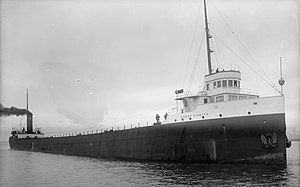User:GreatLakesShips/sandbox/Overhauls/Archive 11
46°54′50.4″N 87°19′58.8″W / 46.914000°N 87.333000°W
 Henry B. Smith c. 1906-1910
| |
| History | |
|---|---|
| Name | Henry B. Smith |
| Operator | Acme Transit Company |
| Port of registry | Fairport, Ohio |
| Builder | American Shipbuilding Company, Lorain, Ohio |
| Yard number | 343 |
| Launched | May 2, 1906 |
| In service | 1906 |
| Out of service | November 9-10, 1913 |
| Identification | US official number 203143 |
| Fate | Sank on Lake Superior |
| General characteristics | |
| Class and type | Lake freighter |
| Tonnage | |
| Length |
|
| Beam | 55 feet (16.8 m) |
| Depth | 31 feet (9.4 m) |
| Installed power |
|
| Propulsion | 1 × fixed pitch propeller |
History[edit]
Background[edit]
In 1843, the gunship USS Michigan, built in Erie, Pennsylvania, became the first iron-hulled vessel built on the Great Lakes.[1] In the mid-1840s, Canadian companies began importing iron vessels prefabricated by shipyards in the United Kingdom. However, it would not be until 1862 that the first iron-hulled merchant ship, Merchant, was built on the Great Lakes.[1] Despite the success of Merchant, wooden vessels remained preferable to iron ones until the 1880s, due to their inexpensiveness, and the abundance of timber.[2][3][4] In the early 1880s, shipyards around the Great Lakes began to construct iron ships on a relatively large scale,[4][5] and in 1884 the first steel freighters were built there.[6][7] By the 1890s, the majority of ships constructed on the lakes were made of steel.[8][9] The late 19th and early 20th centuries saw a rapid increase in the size of lake freighters; the first 400 feet (121.9 m) freighter was built in 1895, the first 500 feet (152.4 m) freighter was constructed five years later.[10]
Design and construction[edit]
Service history[edit]
Final voyage[edit]
Wreck[edit]
Notes[edit]
References[edit]
- ^ a b Bugbee (1) (1962), p. 24.
- ^ Bugbee (1) (1962), p. 26.
- ^ Bowlus (2010), p. 85.
- ^ a b Thompson (1994), p. 32.
- ^ Bugbee (2) (1962), p. 48.
- ^ Bugbee (2) (1962), p. 50.
- ^ Thompson (1994), pp. 40–42.
- ^ Bugbee (2) (1962), p. 49.
- ^ Bugbee (2) (1962), p. 51.
- ^ Thompson (1994), pp. 59–84.
Sources[edit]
- Bowlus, W. Bruce (2010). Iron Ore Transport on the Great Lakes: The Development of a Delivery System to Feed American Industry. Jefferson, North Carolina: McFarland & Company, Inc. ISBN 978-0-786433-26-1. Archived from the original on August 14, 2021. Retrieved March 3, 2021.
- Bugbee (1), Gordon P. (1962). "Iron Merchant Ships: An Upper Lakes Centennial – Part One" (PDF). Detroit, Michigan: Great Lakes Maritime Institute. Archived (PDF) from the original on July 13, 2021. Retrieved February 21, 2021.
{{cite web}}: CS1 maint: numeric names: authors list (link) - Bugbee (2), Gordon P. (1962). "Iron Merchant Ships: An Upper Lakes Centennial – Part Two" (PDF). Detroit, Michigan: Great Lakes Maritime Institute. Archived (PDF) from the original on May 20, 2021. Retrieved February 21, 2021.
{{cite web}}: CS1 maint: numeric names: authors list (link) - Thompson, Mark L. (1994). Queen of the Lakes. Detroit, Michigan: Wayne State University Press. ISBN 0-8143-2393-6. Archived from the original on August 14, 2021. Retrieved February 24, 2021.
